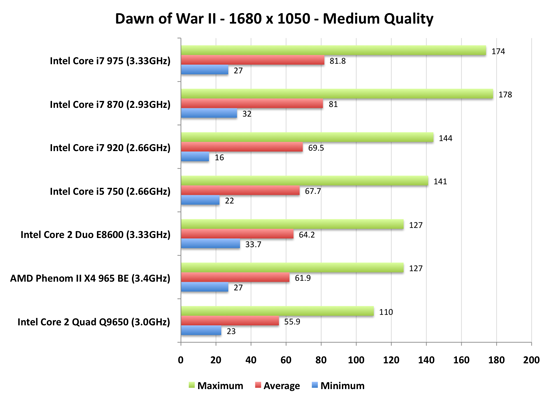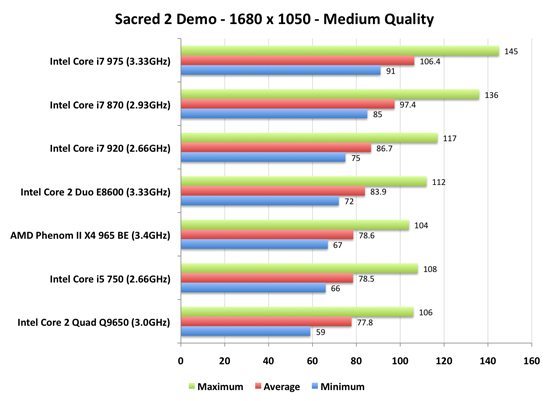Intel's Core i7 870 & i5 750, Lynnfield: Harder, Better, Faster Stronger
by Anand Lal Shimpi on September 8, 2009 12:00 AM EST- Posted in
- CPUs
The Best Gaming CPU?
When I first previewed Lynnfield I theorized that its aggressive turbo modes would make it the best gaming CPU on the market. Most games these days use between two and four threads, not enough for Hyper Threading to be truly beneficial. As a result, Nehalem never really did all that well in games. It was generally faster than the competition, but not much and not on a performance-per-dollar basis.
I ran a few new game tests under Windows 7 to accompany our usual game benchmarks. The competitors here are limited to Lynnfield (of course), Bloomfield, Penryn and AMD's Phenom II.

Dawn of War II doesn't actually shatter any expectations. While turbo clearly benefits Lynnfield, it isn't enough to dethrone Bloomfield. The Core i7 920 is marginally faster than the new i5 750. Here's where things get interesting though: look at minimum frame rates. In both Lynnfield platforms, the minimum frame rates are higher than the competing Bloomfield system. That appears to be Lynnfield's aggressive turbo modes at work. While they're not constantly pushing Lynnfield to a higher clock speed, they do apparently help out when it matters the most.
The other thing to notice is the lowest Lynnfield is a faster gaming CPU than Intel's fastest dual-core: the E8600.

Sacred 2 is an example of performance standings in a more normal manner. Lynnfield can't seem to outperform Bloomfield, and the Core i5 750 actually falls slightly behind AMD's Phenom II X4 965 BE.

With World of Warcraft we're back to turbo mode having a very positive impact. The Core i7 870 is nearly as fast as the i7 975, while the i5 750 is a bit slower than the i7 920. Both are faster than the Phenom II X4 965 BE, which is in turn faster than the Q9650.
These three benchmarks seem to outline the three most realistic options for Lynnfield's gaming performance. In situations where its turbo modes can work, Lynnfield can be equal to if not faster than Bloomfield. In those situations where it doesn't kick in, Lynnfield is at least competitive with Phenom II and Bloomfield. In all situations the old Core 2 Quad Q9650 is at the bottom of the charts.
I'll throw in one more option just to complicate things. Have a look at this:

Not exactly the norm, but here we have the Phenom II X4 965 BE faster than everything - including the Core i7 975. Unfortunately there's no one benchmark that will sum up how these things perform, but overall it looks like Lynnfield is going to be one capable gaming CPU.










343 Comments
View All Comments
strikeback03 - Tuesday, September 8, 2009 - link
How would you have graphics then? You would be limited to the 4xPCIe off the P55 on motherboards which support it, as there are no integrated graphics (yet)MX5RX7 - Tuesday, September 8, 2009 - link
I'm not sure that CPU/GPU integration is a good thing, from a consumer standpoint. At least in the short term.For example, in the article you mention how the majority of modern games are GPU, not CPU limited. The current model allows us to purchase a very capable processor and pair it with a very capable GPU. Then, when the ultra competitive GPU market has provided us with a choice of parts that easily eclipse the performance of the previous generation, we either swap graphics cards for the newer model, or purchase a second now cheaper identical card and (hopefully) double our game performance with SLI or Crossfire. All without having to upgrade the rest of the platform.
With the current model, a new graphics API requires a new graphics card. With Larrabee, it might very well require a whole new platform.
Ben90 - Tuesday, September 8, 2009 - link
Yea, im really excited for Larrabee, who knows if it will be good or not... but with intel kicking ass in everything else, it will at least be interestingWith overclocking performance seemingly being limited by the PCI-E controller, it seems like an unlocked 1156 would be pretty sweet
All in all i gotta admit i was kinda bitter with this whole 1156 thing because i jumped on the 1336 bandwagon and it seemed that Intel was mostly just jacking off with the new socket... but this processor seems to bring a lot more innovation than i expected (just not in raw performance, still great performance though)
chizow - Tuesday, September 8, 2009 - link
Was worried no one was going to properly address one of the main differences between P55 and X58, thanks for giving it a dedicated comparison. Although I would've like to have seen more games tested, it clearly indicates PCIE bandwidth becoming an issue with current generation GPUs. This will only get worst with the impending launch of RV8x0 and GT300.Anand Lal Shimpi - Tuesday, September 8, 2009 - link
PCIe bandwidth on Lynnfield is only an issue with two GPUs, with one you get the same 16 lanes as you would on X58 or AMD 790FX.If I had more time I would've done more games, I just wanted to focus on those that I knew scaled the best to see what the worst case scenario would be for Lynnfield.
In the end 2 GPUs are passable (although not always ideal on Lynnfield), but 4 GPUs are out of the question.
Take care,
Anand
JumpingJack - Thursday, September 10, 2009 - link
Anand, a few other sites have attempted SLI/Xfire work ... on in particular shows 4 GPUs having no impact at all on gaming performance in general -- well, 3 or 4 FPS, but nothing more than a few percentages over norm.Could your configuration with beta or just bad first release drivers be an issue?
Jack
JonnyDough - Tuesday, September 8, 2009 - link
Would it be possible to incorporate two GPU controllers onto a die instead of one or is that what they'll be doing with future procs? I would think that two controllers with a communication hub might supply the needed bandwidth of x16 + x16.Comdrpopnfresh - Tuesday, September 8, 2009 - link
with two gpu's being passable- do you foresee that applying to both two independent gpus, as well as the single dual-card gpus?Ryan Smith - Tuesday, September 8, 2009 - link
Yes. The only difference between the two is where the PCIe bridge chip is. In the former it's on the mobo, in the latter it's on the card itself.Eeqmcsq - Tuesday, September 8, 2009 - link
Talk about bringing a bazooka to a knife fight. AMD better be throwing all their innovation ideas and the kitchen sink into Bulldozer, because Intel is thoroughly out-innovating AMD right now.